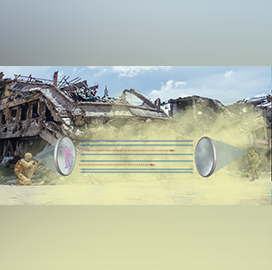
DARPA recently announced its Coded Visibility program, which aims to develop obscurants that will be used to provide warfighters with an asymmetric advantage – where their visibility is enhanced and that of their adversary is suppressed.
Obscurants are used in battlefield situations to protect troops from detection by adversary vision and sensor systems. Along with degrading the enemy’s ability to see, they can disrupt the enemy’s ability to send visual signals, conceal friendly forces, and deceive the enemy. However, obscurants currently in use also degrade visibility and sensor performance of friendly troops, and obscurants designed to counter infrared systems are made of metallic flakes that are dangerous to breathe – requiring troops to wear respirators in combat.
“Coded Visibility aims to develop new types of obscurant particulates that can be tailored to allow U.S. and allied forces to see the enemy through the plume in one direction, while the adversary is unable to see through the plume in the opposite direction,” said Rohith Chandrasekar, program manager in DARPA’s Defense Sciences Office. “We call this passive asymmetry, somewhat like the concept of privacy-window film that allows vision through glass in one direction and not the other. We’ll also explore active asymmetry using novel materials that can be tuned in real time to potentially enable dynamic adaptation of the obscurant’s properties during a mission.”
Creating these new obscurants could be achieved by utilizing scattering media, plasmonics, metamaterials, light-matter interactions, biochemical compounds, and large-scale plume modeling. For example, Ohio University researchers are working with the U.S. Army Research Office to create advanced nanoscale-level smoke screens.
A Broad Agency Announcement describing the program objectives in full is expected to be available on SAM.gov within the next month.
